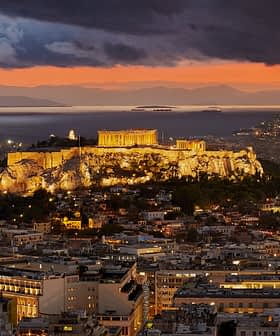A temple of Hercules Olivarius (“Hercules of the Olive Merchants”) is mentioned in the Regionary Catalogue near the Temple of Portunus, and an inscription on a statue-base containing the word Olivarius and the sculptor’s name was found near the Round Temple, leading some to conclude that the Hercules Victor worshiped here was more commonly considered a special patron of the olive-oil merchants. As such, it would be a temple not financed by the military booty of the political elite, but by business people, in keeping with the character of this region of the city. (Peter Aicher, Rome Alive: A Source Guide to the Ancient City, vol. 1, Bolchazy-Carducci: 2004)
During the Roman Empire, production and subsequent sales of olive oil represented one of the most common modes of survival. In fact, we are aware of the existence of various professional centers associated with this ancestral foodstuff. Almost all of them, were in the geographic area around Corduba (Córdoba) and Hispalis (Seville), which logically included maintenance of the navigability of the rivers (particularly, el Baetis, now known as the Guadalquivir, and the Salsum, now known as the Genil, which could be sailed as far as Cordova and Écija, respectively, which is why they immediately became Hispanic capitals of the oil trade, as they dominated the main product departure points from the Mediterranean).
The majority of these entrepreneurs and traders were documented in epigraphic supports from the second half of the II Century A.D. (times of Antoninus Pius and Marcus Aurelius), when the boom in Andalusian oil exports to the Urbs took place.
Let’s take a look at some of them.
Mercatores olei Hispani
This is the case of L. Marius Phoebus, mercator olei Hispani ex provincia Baetica, known from an inscription that appeared in Rome itself (C.I.L. ‑Corpus Inscriptionum Latinarum- VI, 1935) and the tituli picti of the Testaccio (C.I.L. XV, 3943 – 3959). A new epigraph of Cordovese origin, dated from the second half of the II Century AD (C.I.L. II/7, 544) also appears to allude to him, in a document of enormous interest for the understanding of the scope of the family and economic relations of these powerful traders. This is what J. Remesal calls “the microhistory of Baetican oil”. In the opinion of this researcher, who has studied this and many other texts in detail, he was a freedman married to a freedwoman (ingenua), with whom he also had two freed children, all four mentioned in the titulus.
Navicularii and negotiatores
Although the terms navicularius, negotiator, mercator or diffusor all appear to be synonymous, or at least they were occasionally used to mean the same thing, the people of the period must have perfectly understood the differences between them, meaning that their functions must have been different.
It would not appear to be logical to invent new names for an office that already had one; and even less so in the same region. Thus, navicularius must have been responsible for transporting the oil pertaining to the State destined for the Annona, in exchange for a corresponding stipend. On the contrary, the negotiatores, which facilitated the task of those supplying their own production or that of others, did not receive any money for it. In exchange for their labour, they received prebends, tax advantages and different types of benefits.
Occasionally, judging by the epigraph, they shared this function with the mercatores, which makes the definition of their respective functions difficult.
Diffusores
They were documented both in Rome and in Baetica, even when the majority of them were based in Astigi (Écija). They were highly mobile intermediaries, and they would put the great producers in touch with the oil traders, working in the service of the State and getting the best and most complete supply possible for Rome. Possibly, they did their work from some official headquarters located precisely in the Astigi capital.
Quite often, these posts were occupied by freedmen (generally, they bore no relationship whatsoever to the producers) and, as shown by the epigraphic testimony, they fell to the same family over various generations.
Procurator Baetis (or ad ripam Baetis)
This post appears in an inscription preserved at the base of the Giralda, dedicated to the equites (gentleman) Sextus Iulius Possesor, son of Iulius, of the Quirina tribe and native of Mactar, in Africa, for the corporations of boatmen of Seville (scapharii hispalenses).
The epigraph in question gives a precise account of the cursus onorum accumulated by Iulius Possesor over a lifetime replete with positions and responsibilities. In fact, he was the prefect’s assistant of the Annona during the third third of the II Century AD. He was responsible for exporting African and Andalusian oil to Rome for distribution to the plebe and the army, as well as for paying the navicularii and incentivising the oil collection.
These functions included that of procurator augustorum ad ripam Baetis (commissioned by the emperors Marcus Aurelius and Lucius Verus, around 169 A.D.); or, in other words, responsible for regulating and maintaining the public course of the river (through dykes, ports and channels) as a fundamental pathway for exportation, payment of the boatmen and control of the same. Oddly, they dedicated the homage to him for the honour he showed in his post.









